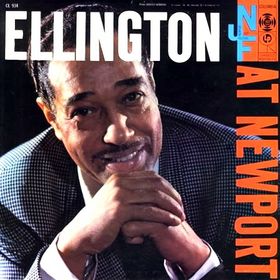
Ellington at Newport is a 1956 live jazz album by Duke Ellington and his band of their 1956 concert at the Newport Jazz Festival, a concert which revitalized Ellington's flagging career. Jazz promoter George Wein describes the 1956 concert as "the greatest performance of [Ellington's] career... It stood for everything that jazz had been and could be." It is included in the book 1001 Albums You Must Hear Before You Die, which ranks it "one of the most famous... in jazz history". Jazz journalist Scott Yanow wrote that Ellington's performance at the 1956 Newport Jazz Festival caused a sensation that fueled the rest of his career.The original release was partly recreated in the studio after the Ellington Orchestra's festival appearance.

...And His Mother Called Him Bill is a studio album by Duke Ellington recorded in the wake of the 1967 death of his long-time collaborator, Billy Strayhorn. It won the Grammy Award for Best Large Jazz Ensemble Album in 1968.

Far East Suite is an album by Duke Ellington that won the Grammy Award in 1968 for Best Instrumental Jazz Performance – Large Group or Soloist with Large Group. Ellington and Billy Strayhorn wrote the compositions. The album was reissued in 1995 with four previously unreleased alternate takes. In 2003, Bluebird Records issued the album on CD with additional bonus takes.
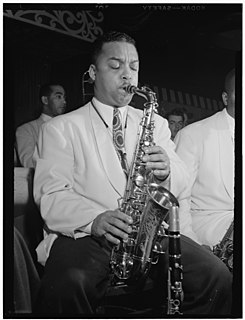
Russell Procope was an American clarinetist and alto saxophonist who was a member of the Duke Ellington orchestra.

Jimmy Hamilton was an American jazz clarinetist and saxophonist, who was a member of the Duke Ellington Orchestra.
"Diminuendo and Crescendo in Blue" is a jazz composition written in 1937 by Duke Ellington and recorded for the first time on May 15, 1937 by the Duke Ellington Orchestra with Wallace Jones, Cootie Williams (trumpet), Rex Stewart (cornet), Barney Bigard (clarinet), Johnny Hodges, Otto Hardwick, Laurence Brown, Joe Nanton (trombone), Harry Carney, Sonny Greer (drums), Wellmann Braud (bass), Freddie Guy (guitar), and Duke Ellington (piano). No tenor saxophone was present in this recording section, nor in "Crescendo in Blue," which was recorded the same day. In its early form, the two individual pieces, "Diminuendo in Blue" and "Crescendo in Blue," were recorded on opposite sides of a 78 rpm record. The 1956 performance at the Newport Jazz Festival revitalized Ellington's career, making newspaper headlines when seated audience members chaotically began rising to dance and stand on their chairs during Paul Gonsalves's tenor saxophone solo.
Black, Brown and Beige is an extended jazz work written by Duke Ellington for his first concert at Carnegie Hall, on January 23, 1943.
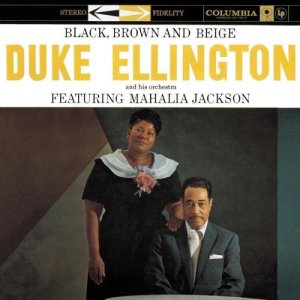
Black, Brown and Beige is a 1958 jazz album by Duke Ellington and his orchestra, featuring Mahalia Jackson.
This is the discography of recordings by Duke Ellington, including those nominally led by his sidemen, and his later collaborations with musicians with whom Ellington had generally not previously recorded.
Sacred Concert by Duke Ellington is one of the following realisations:
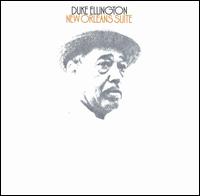
New Orleans Suite is a studio album by the American pianist, composer, and bandleader Duke Ellington, recorded and released on the Atlantic label in 1970. The album contains the final recordings of longtime Ellington saxophonist Johnny Hodges, who died between the album's two recording sessions. The album won a Grammy Award in 1971 for Best Jazz Performance by a Big Band.

Masterpieces by Ellington is the first LP album by American pianist, composer, and bandleader Duke Ellington, recorded for the Columbia label in 1950. It was one of the earliest 12-inch LPs to take advantage of the extended time available and consisted of four tracks, three of them "concert arrangements" of Ellington standards and one, "The Tattooed Bride," a recent tone poem.

Ellington Uptown is an album by American pianist, composer and bandleader Duke Ellington recorded for the Columbia label in 1951 & 1952. The album was re-released on CD in 2004 with additional tracks recorded in 1947 and originally released as the Liberian Suite EP.

Liberian Suite is an album by American pianist, composer and bandleader Duke Ellington recorded for the Columbia label in 1947. The album was Ellingon's second 10" LP album and one of his earlier works on the Columbia label. The suite represents one of Ellington's early extended compositions and was commissioned for the Liberian centennial. The Liberian Suite was released on CD as bonus tracks on Ellington Uptown in 2004.

Swinging Suites by Edward E. & Edward G. is an album by American pianist, composer and bandleader Duke Ellington recorded for the Columbia label in 1960 featuring a jazz interpretation of Peer Gynt by Grieg and Ellington's tribute to John Steinbeck's Sweet Thursday, co-written by Billy Strayhorn. The album was rereleased on CD as Three Suites along with Ellington's reworking of Tchaikovsky's The Nutcracker in 1990.

The Carnegie Hall Concerts: December 1944 is a live album by American pianist, composer and bandleader Duke Ellington recorded at Carnegie Hall, in New York City in 1944 and released on the Prestige label in 1977.

The Carnegie Hall Concerts: January 1943 is a live album by American pianist, composer and bandleader Duke Ellington recorded at Carnegie Hall, in New York City in 1943 and released on the Prestige label in 1977.
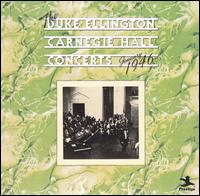
The Carnegie Hall Concerts: January 1946 is a live album by American pianist, composer and bandleader Duke Ellington recorded at Carnegie Hall, in New York City in 1946 and released on the Prestige label in 1977.

The Carnegie Hall Concerts: December 1947 is a live album by American pianist, composer and bandleader Duke Ellington recorded at Carnegie Hall, in New York City in 1947 and released on the Prestige label in 1977.
"Come Sunday" is a piece by Duke Ellington, which became a jazz standard. It was written in 1942 as a part of the first movement of a suite entitled Black, Brown and Beige. Ellington was engaged for a performance at Carnegie Hall on January 23, 1943, for which he wrote the entire composition. In 1958 he revised the piece and recorded it in its entirety for the 1958 album of the same name. "Come Sunday" was originally a centerpiece for alto saxophone player Johnny Hodges; the 1958 album, which contained a vocal version of the piece with new lyrics by Ellington featuring gospel singer Mahalia Jackson, greatly increased its popularity.















